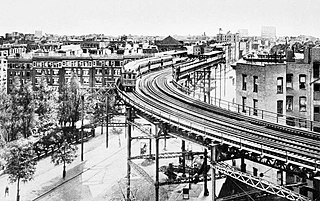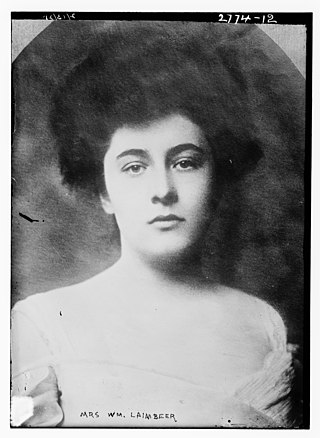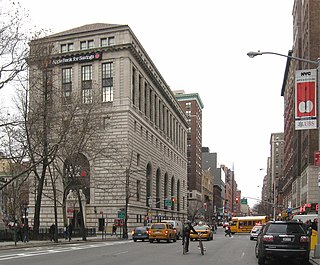Related Research Articles

M. M. Warburg & CO KGaA is a German private bank, based in Hamburg. A family-owned bank, it was founded in 1798 by brothers Moses Marcus Warburg and Gerson Warburg, two members of the Warburg family. The bank was Aryanized under the Nazis. The Warburg family still owns the bank, continuing a more than 200-year legacy of private ownership.
14 Wall Street, originally the Bankers Trust Company Building, is a skyscraper at the intersection of Wall Street and Nassau Street in the Financial District of Manhattan in New York City. The building is 540 feet (160 m) tall, with 32 usable floors. The original 540-foot tower is at the southeastern corner of the site, and a shorter annex wraps around the original tower.
Bayside Cemetery is a Jewish cemetery at 80-35 Pitkin Avenue in Ozone Park, Queens, New York City. It covers about 12 acres (4.9 ha) and has about 35,000 interments. It is bordered on the east by Acacia Cemetery, on the north by Liberty Avenue, on the west by Mokom Sholom Cemetery, and on the south by Pitkin Avenue.

110th Street is a street in the New York City borough of Manhattan. It is commonly known as the boundary between Harlem and Central Park, along which it is known as Central Park North. In the west, between Central Park West/Frederick Douglass Boulevard and Riverside Drive, it is co-signed as Cathedral Parkway.

Meyer Jacobstein was an American educator and politician who served three terms as a member of the United States House of Representatives from New York from 1923 to 1929.

1 William Street is an office building in the Financial District of Lower Manhattan in New York City. The building was erected in 1906–1907 and was designed by Francis H. Kimball in conjunction with Julian Clarence Levi. It was created for the Seligmans, a prominent German Jewish family who founded an investment bank called J. & W. Seligman. The building was later the headquarters of investment bank Lehman Brothers from 1929 to 1980, and was subsequently bought by Banca Commerciale Italiana.

23 Wall Street is a four-story office building in the Financial District of Manhattan in New York City, at the southeast corner of Wall Street and Broad Street. Designed by Trowbridge & Livingston in the neoclassical style and constructed from 1913 to 1914, it was originally the headquarters of J.P. Morgan & Co. Since the late 2000s, the building has remained unoccupied for long periods, although it has occasionally been used for events.

48 Wall Street, formerly the Bank of New York & Trust Company Building, is a 32-story, 512-foot-tall (156 m) skyscraper on the corner of Wall Street and William Street in the Financial District of Lower Manhattan in New York City. Built in 1927–1929 in the Neo-Georgian and Colonial Revival styles, it was designed by Benjamin Wistar Morris.

55 Wall Street, formerly the National City Bank Building, is an eight-story building on Wall Street between William and Hanover streets in the Financial District of Lower Manhattan in New York City, New York, United States. The lowest three stories were completed in either 1841 or 1842 as the four-story Merchants' Exchange and designed by Isaiah Rogers in the Greek Revival style. Between 1907 and 1910, McKim, Mead & White removed the original fourth story and added five floors to create the present building. The facade and part of the interior are New York City designated landmarks, and the building is listed on both the New York State Register of Historic Places and the National Register of Historic Places (NRHP) as a National Historic Landmark. It is also a contributing property to the Wall Street Historic District, listed on the NRHP.

49 Chambers, formerly known as the Emigrant Industrial Savings Bank Building and 51 Chambers Street, is a residential building at 49–51 Chambers Street in the Civic Center neighborhood of Manhattan in New York City. It was built between 1909 and 1912 and was designed by Raymond F. Almirall in the Beaux-Arts style. The building occupies a slightly irregular lot bounded by Chambers Street to the south, Elk Street to the east, and Reade Street to the north.

The Pershing Square Building, also known as 125 Park Avenue or 100 East 42nd Street, is a 25-story office building in Midtown Manhattan in New York City. It is located on the eastern side of Park Avenue between 41st and 42nd streets, across from Grand Central Terminal to the north and adjacent to 110 East 42nd Street to the east.

The Bank of the Metropolis was a bank in New York City that operated between 1871 and 1918. The bank was originally located at several addresses around Union Square in Manhattan before finally moving to 31 Union Square West, a 16-story Renaissance Revival building designed by Bruce Price and built between 1902 and 1903.

Louis Lipsky was an American Zionist leader, President of the Zionist Organization of America, magazine editor, and author of books on Jewish culture and politics.

David Michael Solomon is an American investment banker and the chief executive officer (CEO) of Goldman Sachs, a position he has held since October 2018. He has also been chairman of the bank since January 2019. Before assuming his role as CEO, Solomon was president and chief operating officer from January 2017 to September 2018, and was joint head of the investment banking division from July 2006 to December 2016. Solomon formally succeeded Lloyd Blankfein, the previous CEO, on October 1, 2018, and was named chairman after Blankfein's retirement.

110 East 42nd Street, also known as the Bowery Savings Bank Building, is an 18-story office building in Midtown Manhattan, New York City, United States. The structure was designed in the Italian Romanesque Revival style by York and Sawyer, with William Louis Ayres as the partner in charge. It is on the south side of 42nd Street, across from Grand Central Terminal to the north and between the Pershing Square Building to the west and the Chanin Building to the east. 110 East 42nd Street is named for the Bowery Savings Bank, which had erected the building as a new branch structure to supplement its original building at 130 Bowery. The building was erected within "Terminal City", a collection of buildings above the underground tracks surrounding Grand Central, and makes use of real-estate air rights above the tracks. The building is directly above the New York City Subway's Grand Central–42nd Street station.

Nathalie Schenck Laimbeer was an American banker, philanthropist, and socialite.

275 Madison Avenue is a 43-story office building in the Murray Hill neighborhood of Manhattan in New York City. It is along the southeast corner of Madison Avenue and 40th Street, near Grand Central Terminal. The building, constructed from 1930 to 1931, was designed by Kenneth Franzheim in a mixture of the Art Deco and International styles.
Herbert M. Singer was an American lawyer and philanthropist. He was the chairman of the executive committee of PepsiCo and was leader and trustee of many civic organizations including the American Jewish Joint Distribution Committee and Beth Israel Medical Center.

The Bowery Savings Bank Building, also known as 130 Bowery, is an event venue and former bank building in the Little Italy and Chinatown neighborhoods of Lower Manhattan in New York City. Constructed for the defunct Bowery Savings Bank from 1893 to 1895, it occupies an L-shaped site bounded by Bowery to the east, Grand Street to the south, and Elizabeth Street to the west. The Bowery Savings Bank Building was designed by Stanford White of McKim, Mead & White. Since 2002, it has hosted an event venue called Capitale. The building's facade and interior are New York City designated landmarks, and the building is listed on the National Register of Historic Places.

The Apple Bank Building, also known as the Central Savings Bank Building and 2100 Broadway, is a bank and residential building at 2100–2114 Broadway on the Upper West Side of Manhattan in New York City. Constructed as a branch of the Central Savings Bank, now Apple Bank, from 1926 to 1928, it occupies a trapezoidal city block bounded by 73rd Street to the south, Amsterdam Avenue to the east, 74th Street to the north, and Broadway to the west. The Apple Bank Building was designed by York and Sawyer in the Renaissance Revival and palazzo styles, patterned after an Italian Renaissance-style palazzo.
References
- ↑ Tobias, Michael (January 2010). "Grajewo Births, Marriages 1834-43, 52-53, 55-57 Deaths 1834-43,45,52-53,55-57". Jewish Records Indexing - Poland.
- ↑ Kobrin, Rebecca (2018-12-14), "Jewish Immigrant Bankers, New York Real Estate, and American Finance, 1870–1914", Doing Business in America, Purdue University Press, pp. 49–76, doi:10.2307/j.ctvh9w101.7, ISBN 978-1-61249-559-0 , retrieved 2023-04-10
- 1 2 3 Polland, Annie (2009), Landmark of the Spirit: The Eldridge Street Synagogue, Yale University Press, doi:10.12987/9780300142839-003
- ↑ Polland, Annie; Soyer, Daniel (2015). Emerging Metropolis: New York Jews in the Age of Immigration, 1840-1920. NYU Press. p. 107. ISBN 9781479811052.
- ↑ H., Jaffe, Steven (2014). Capital of capital : money, banking + and power in New York City, 1784-2012. Columbia Univ. Press. ISBN 978-0-231-16910-3. OCLC 882985050.
{{cite book}}: CS1 maint: multiple names: authors list (link) - ↑ Moore, Deborah Dash; Gurock, Jeffrey S.; Polland, Annie; Rock, Howard B.; Soyer, Daniel (2020). Jewish New York: The Remarkable Story of a City and a People. New York University Press. p. 91. ISBN 9781479802647.
- ↑ D., Sarna, Jonathan (2005). American Judaism : a history. Yale University Press. ISBN 0-300-10976-8. OCLC 1037503490.
{{cite book}}: CS1 maint: multiple names: authors list (link) - ↑ Gray, Christopher (2007-02-25). "A Wave of Change for a Quiet Block". The New York Times. ISSN 0362-4331 . Retrieved 2023-04-10.
- ↑ Kobrin, Rebecca (2013). "Destructive Creators: Sender Jarmulowsky and Financial Failure in the Annals of American Jewish History". American Jewish History. 97 (2): 105–137. doi:10.1353/ajh.2013.0010. ISSN 1086-3141.
- ↑ Lipsky, Louis (1975). Memoirs in profile. Jewish Publication Society of America. ISBN 0-8276-0069-0. OCLC 1313739026.
- ↑ "ONLY $501,053 LEFT BY JARMULOWSKY; East Side Banker Had Been Reputed to be a Multi-Millionaire". The New York Times. 1913-08-14. ISSN 0362-4331 . Retrieved 2023-04-10.
- ↑ "Ticket to Riches". סגולה. Retrieved 2023-04-10.
- ↑ Gray, Christopher (1990-11-11). "Streetscapes: Harlem's Lafayette Theater; Jackhammering the Past". The New York Times. ISSN 0362-4331 . Retrieved 2023-04-10.
- ↑ Gray, Christopher (1991-05-26). "The Unmaking of a 'Landmark'". The New York Times. ISSN 0362-4331 . Retrieved 2023-04-10.